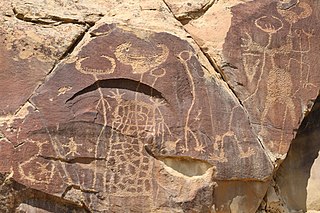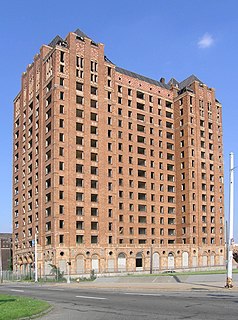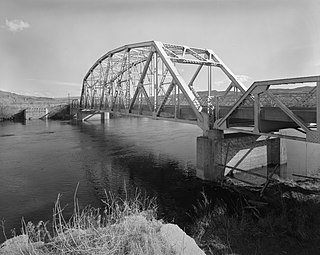
Hot Springs County is a county in the U.S. state of Wyoming. As of the 2010 United States Census, the population was 4,812, making it the second-least populous county in Wyoming. Its county seat is Thermopolis. The county is named for the hot springs located in Hot Springs State Park.

Thermopolis is the largest town in Hot Springs County, Wyoming, United States, and also the county seat. As of the 2010 U.S. Census, the town population was 3,009.

Hot Springs State Park is a public recreation area in Thermopolis, Wyoming, known for its hot springs, which flow at a constant temperature of 135° Fahrenheit. The state park offers free bathing at the State Bath House, where temperatures are moderated to a therapeutic 104 °F. The petroglyph site at Legend Rock, some 25 miles away, is also part of the park. The park is managed by the Wyoming Division of State Parks and Historic Sites.

Legend Rock Petroglyph Site is located in Hot Springs County, Wyoming, 20 miles northwest of Hot Springs State Park. Legend Rock is a petroglyph site which features hundreds of individual petroglyphs spread across the face of the rock. Although a handful of the rock's etchings have variously been eroded and defaced, a wide majority have been preserved for public viewing. The nearly 300 individual petroglyphs feature some of the oldest and best examples of Dinwoody rock art in the world. The origins of the petroglyphs are still subject to debate. The site was listed on the National Register of Historic Places on July 5, 1973. and it is preserved by the state of Wyoming as a state historic site.

The Lee Plaza is a vacant 15-story high-rise apartment building located at 2240 West Grand Boulevard, about one mile west of New Center along West Grand Boulevard, an area in Detroit, Michigan. It is a registered historic site by the state of Michigan and was added to the United States National Register of Historic Places on November 5, 1981. Designed by Charles Noble and constructed in 1929, it rises to 15 floors and is an excellent example of Art Deco architecture of the 1920s.
Plaza Hotel is a hotel in New York City.

The Sugar Hill Historic District is a historic district in Detroit, Michigan. It contains 14 structures located along three streets: East Forest, Garfield, and East Canfield, between Woodward Avenue on the west and John R. on the east. The district was listed on the National Register of Historic Places in 2003.

The Alamo Plaza Historic District is a historic district of downtown San Antonio in the U.S. state of Texas. It was listed on the National Register of Historic Places in 1977. It includes the Alamo, which is a separately listed Registered Historic Place and a U.S. National Historic Landmark.

The Cass–Davenport Historic District is a historic district containing four apartment buildings in Detroit, Michigan, roughly bounded by Cass Avenue, Davenport Street, and Martin Luther King, Jr. Boulevard. The district was listed on the National Register of Historic Places in 1997. The Milner Arms Apartments abuts, but is not within, the district.

The Cass Park Historic District is a historic district in Midtown Detroit, Michigan, consisting of 25 buildings along the streets of Temple, Ledyard, and 2nd, surrounding Cass Park. It was listed on the National Register of Historic Places in 2005 and designated a city of Detroit historic district in 2016.

The Park Avenue House is a high rise residential building located at 2305 Park Avenue in the Park Avenue Historic District in Downtown Detroit, Michigan. It was listed on the National Register of Historic Places in 1996. It should not be confused with the nearby Park Avenue Hotel, which was demolished in 2015.

The Mammoth Hot Springs Historic District in Yellowstone National Park comprises the administrative center for the park. It is composed of two major parts: Fort Yellowstone, the military administrative center between 1886–1918, and now a National Historic Landmark, and a concessions district which provides food, shopping, services, and lodging for park visitors and employees.

The Park Plaza Apartments were one of the first and most prominent art deco apartment buildings erected in the Bronx in New York City. The eight-story, polychromatic terra cotta embellished structure at 1005 Jerome Avenue and West 164th Street was designed by Horace Ginsberg and Marvin Fine and completed in 1931. It is an eight-story building divided into five blocks or section, each six bays wide. There are about 200 apartments, ranging from one to five rooms.

The CQA Four Mile Bridge spans the Big Horn River in Hot Springs County, Wyoming. The bridge was erected in 1927-28 by the Charles M. Smith Company and spans 175 feet (53 m) with a total length of 295 feet (90 m). The rigid 7-panel Pennsylvania through-truss was nominated for inclusion on the National Register of Historic Places as one of forty bridges throughout Wyoming that collectively illustrate steel truss construction, a technique of bridge design that has become obsolete since the mid-twentieth century. The bridge rests on concrete piers and abutments and is approached by two Warren pony trusses.

The EFP Bridge spans Owl Creek in Hot Springs County, Wyoming. The bridge was erected in 1919–20 by the Monarch Engineering Company of Denver and spans 124 feet (38 m) with a total length of 126 feet (38 m). The rigid 7-panel Parker (camelback) through-truss was nominated for inclusion on the National Register of Historic Places as one of forty bridges throughout Wyoming that collectively illustrate steel truss construction, a technique of bridge design that has become obsolete since the mid-twentieth century. The bridge is supported on sandstone abutments and has a timber deck, 15 feet (4.6 m) in width.

The Alex Halone House in Thermopolis, Wyoming, was built by Finnish immigrant Alex Halone for his personal residence in 1909–1910. Halone, a stonemason, built several stone structures in Thermopolis. Three generations of the Halone family were stonemasons. The grounds include a log Finnish sauna built by Alex and Eugene Halone with assistance from Lauri Suikaonen in 1946-51.

The Hailey Masonic Lodge refers to a historic building, which was built in 1937 in Hailey, Idaho. The building was constructed as a meeting hall for Hailey Lodge No. 16, a local chapter of the Freemasons. It was listed on the National Register of Historic Places in 2008.

The Perry Plaza Court Historic District encompasses a historic tourist accommodation at 1007 Park Avenue in Hot Springs, Arkansas. It consists of a long two-story brick building in the International style, along with a small office building and swimming pool. It houses 19 single-bedroom units, which are now rented as apartments. Built in 1947–48, it is a fine example of the International Style. The unit interiors retain a number of period features, including tile and plumbing fixtures.

Historic Hotels of America is a program of the National Trust for Historic Preservation that was founded in 1989 with 32 charter members; the programs accepts nominations and identifies hotels that have maintained their authenticity, sense of place, and architectural integrity. As of June 5, 2015, the program included over 260 members in 44 states, including the District of Columbia, Puerto Rico, and the U.S. Virgin Islands.

The Plaza Hotel was a building in the King-Lincoln Bronzeville neighborhood of Columbus, Ohio. It was built c. 1895 and was listed on the National Register of Historic Places in 1984.





















